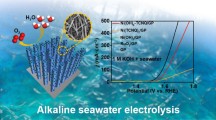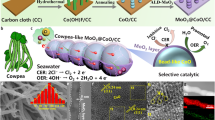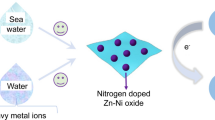Abstract
To improve both oxygen evolution efficiency and stability at high temperatures, Mn, Mn+Mo, Mn+Mo+V, and Mn+Fe+V oxide electrodes were prepared on a Ti substrate, with an intermediate layer of IrO2, by an anodic deposition method. The crystal structure, surface morphology, pore size distribution, specific surface area, and voltammetric charge were then characterized for each electrode. The results demonstrated that for Mn-O electrodes, the preferential orientation of the (100) crystal plane and the mesopore structure played negative roles in the oxygen evolution reaction. On the basis of the electrocatalytic properties of MnO2- based electrodes in seawater, the outer surface voltammetric charge at a scan rate of 500 mV·s−1 was shown to effectively indicate whether oxygen evolution reactions were preferred over chlorine evolution reactions. The Mn-O electrode exhibited oxygen evolution efficiency of only 47.27%, whereas the Mn+Mo, Mn+Mo+V and Mn+Fe+V oxide electrodes displayed oxygen evolution efficiency of nearly 100%. This means that adding Mo, V, and Fe elements to the electrode can improve its crystal structure and morphology as well as further enhancing its oxygen evolution efficiency.
Similar content being viewed by others
References
Contaldi M, Gracceva F, Mattucci A. Hydrogen Perspectives in Italy: Analysis of Possible Deployment Scenarios[J]. International Journal of Hydrogen Energy, 2008,33(6): 1 630–1 642
Lee D H, Lee D J. Hydrogen Economy in Taiwan and Biohydrogen[J]. International Journal of Hydrogen Energy, 2008,33(5): 1 607–1 618
Martinez S, Metikoš–Huković M, Valek L. Electrocatalytic Properties of Electrodeposited Ni–15Mo Cathodes for the HER in Acid Solutions: Synergistic Electronic Effect[J]. Journal of Molecular Catalysis A Chemical, 2006,245(1): 114–121
Rosalbino F, Delsante S, Borzone G, et al. Correlation of Microstructure and Catalytic Activity of Crystalline Ni–Co–Y Alloy Electrode for the Hydrogen Evolution Reaction in Alkaline Solution[J]. Journal of Alloys and Compounds, 2007,429(1): 270–275
Wei Z D, Yan A Z, Feng Y C, et al. Study of Hydrogen Evolution Reaction on Ni–P Amorphous Alloy in the Light of Experimental and Quantum Chemistry[J]. Electrochemistry Communications, 2007,9(11): 2 709–2 715
Song H Y, Kondrikov N B, Kuryavy V G, et al. Preparation and Characterization of Manganese Dioxide Electrodes for Highly Selective Oxygen Evolution during Diluted Chloride Solution Electrolysis[J]. Journal of Industrial and Engineering Chemistry, 2007, 13(4): 545–551
Bhattarai J. Effects of Tin, Antimony and Molybdenum in Mn–W–O/Ir1–x–ySnyO2+0.5y /Ti Anodes for Oxygen Evolution in Seawater Electrolysis[ J]. Scientific World, 2010, 8(8): 39–43
Fujimura K, Matsui T, Izumiya K, et al. Oxygen Evolution on Manganese–molybdenum Oxide Anodes in Seawater Electrolysis[J]. Materials Science and Engineering A, 1999, 267(2): 254–259
Habazaki H, Matsui T, Kawashima A, et al. Nanocrystalline Manganese–molybdenum–tungsten Oxide Anodes for Oxygen Evolution in Seawater Electrolysis[J]. Scripta Materialia, 2005, 44(8): 1 659–1 662
Ghany N A A, Kumagai N, Meguro S, et al. Oxygen Evolution Anodes Composed of Anodically Deposited Mn–Mo–Fe Oxides for Seawater Electrolysis[J]. Electrochimica Acta, 2003, 48(1): 21–28
Kato Z, Bhattarai J, Kumagai N, et al. Durability Enhancement and Degradation of Oxygen Evolution Anodes in Seawater Electrolysis for Hydrogen Production[J]. Applied Surface Science, 2011, 257(19): 8 230–8 236
Jiang N, Meng H M. The Durability of Different Elements Doped Manganese Dioxide–coated Anodes for Oxygen Evolution in Seawater Electrolysis[J]. Surface and Coatings Technology, 2012, 206(21): 4 362–4 367
Ishihara A, Motohira N, Ota K, et al. High Temperature Electrochemical Heat Pump Using Water Gas Shift Reaction. Part I: Theoretical Considerations[J]. Journal of Applied Electrochemistry, 1999, 29(9): 1 079–1 084
Doenitz W, Schmidberger R, Steinheil E, et al. Hydrogen Production by High Temperature Electrolysis of Water Vapor[J]. International Journal of Hydrogen Energy, 1980, 5(1): 55–63
Balaji R, Kannan B S, Lakshmi J, et al. An Alternative Approach to Selective Sea Water Oxidation for Hydrogen Production[J]. Electrochemistry Communications, 2009,11(8): 1 700–1 702
Shin W C, Yoon S G. Characterization of RuO2 Thin Films Prepared by Hot–wall Metall Organic Chemical Vapor Deposition[J]. Journal of the Electrochemical Society, 1997, 144(3): 1 055–1 060
Trasatti S, DaSilva L A, Alves V A, et al. Oxygen Evolution in Acid Solution on IrO2+TiO2 Ceramic Films. A Study by Impedance, Voltammetry and SEM[J]. Electrochimica Acta, 1997, 42(2): 271–281
Trasatti S, De Faria L A, Boodts J F C. Electrocatalytic Properties of Ru+Ti+Ce Mixed Oxide Electrodes for the Cl2 Evolution Reaction[J]. Electrochimica Acta, 1997, 42(23–24): 3 525–3 530
Chen Y X, Xia X X, Chen Y Y, et al. XRD Studies and Electrochemical Surface Spectrum of RuO2–SnO2 Mixed Metal Oxides Electrode[J]. Journal of Chemical Industry and Engineering, 1996, 47(1): 42–47(in Chinese)
Song L J, Meng H M. Effect of Carbon Content on Ni–Fe–C Electrodes for Hydrogen Evolution Reaction in Seawater[J]. International Journal of Hydrogen Energy, 2010, 35(19): 10 060–10 066
Author information
Authors and Affiliations
Corresponding author
Additional information
Funded by National Natural Science Foundation of China (No. 51301070), Scientific and Technological Project of Henan Province (No. 182102210068)
Rights and permissions
About this article
Cite this article
Yan, Z., Song, L., Tang, M. et al. Oxygen Evolution Efficiency and Chlorine Evolution Efficiency for Electrocatalytic Properties of MnO2-based Electrodes in Seawater. J. Wuhan Univ. Technol.-Mat. Sci. Edit. 34, 69–74 (2019). https://doi.org/10.1007/s11595-019-2016-z
Received:
Accepted:
Published:
Issue Date:
DOI: https://doi.org/10.1007/s11595-019-2016-z




